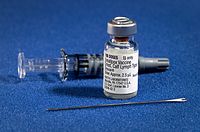
Photo from wikipedia
An HIV candidate vaccine for the Chinese population was designed by constructing a recombinant fowlpox virus expressing HIV-1 gag and HIV gp145 proteins via homologous recombination and plaque screening using… Click to show full abstract
An HIV candidate vaccine for the Chinese population was designed by constructing a recombinant fowlpox virus expressing HIV-1 gag and HIV gp145 proteins via homologous recombination and plaque screening using enhanced green fluorescent protein (EGFP) as the reporter gene. EGFP in the recombinant was then knocked out with the Cre/Loxp system yielding rFPVHg-Hp, which was identified at the genomic, transcriptional and translational levels. The immunogenicity of rFPVHg-Hp was analyzed by measuring levels of HIV-specific antibodies and IFN-γ-secreting splenocytes by enzyme-linked immunosorbent assay and IFN enzyme-linked immune spot test in the BALB/c mouse model. Results showed that rFPV could not stimulate HIV-1 specific antibodies or IFN-γ-secreting cells by a single immunization. Meanwhile, in the prime-boost strategy, HIV-p24 antibodies (P < 0.01) and IFN-γ-secreting cells (P < 0.05) were induced strongly by the candidate vaccine after the boost immunization. Thus, both humoral and cellular immunity could be elicited by the candidate vaccine in a prime-boost immunization strategy. This study provides a foundation for future preclinical studies on the HIV rFPVHg-Hp candidate vaccine.
Journal Title: Indian Journal of Microbiology
Year Published: 2017
Link to full text (if available)
Share on Social Media: Sign Up to like & get
recommendations!